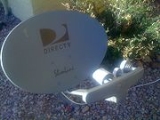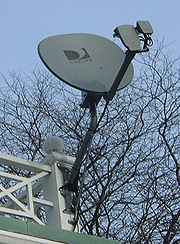
DirecTV-10
Encyclopedia
DirecTV-10 is a Boeing model 702
direct broadcast satellite
that provides high definition television (HDTV) to DirecTV subscribers in North America
. It was launched by International Launch Services
on July 7, 2007 from the Baikonur Cosmodrome
in Kazakhstan
aboard an Enhanced Proton Breeze-M
rocket. After about two months of in-orbit testing, the satellite was moved to its operating position at 102.775° west longitude. This was the third DirecTV satellite launched on a Proton rocket. Prior launches include DirecTV-8, which was launched on May 22, 2005, and DirecTV-5
, which was launched on May 7, 2002.
DirecTV contracted with Boeing in 2004 to build three identical 702 model satellites — DirecTV-10, 11
and 12
. DirecTV-11 was launched on March 19, 2008 and DirecTV-12 was launched on December 29, 2009. The satellites were purchased to significantly increase the number of national and local HDTV channels DirecTV offers.

 DirecTV-10 transmits MPEG-4
DirecTV-10 transmits MPEG-4
encoded signals, a compression standard which is more efficient than MPEG-2
which DirecTV uses for standard definition and a small number of HD channels. The use of MPEG-4 compression allows the satellite to carry significantly more channels than it could using MPEG-2 compression. Receiving signals from DirecTV-10 requires an advanced receiver capable of decoding MPEG-4 signals, such as the H21 or HR21, and a 5-LNB Ku/Ka dish, such as the AT-9 "Sidecar". These receivers also receive MPEG-2 channels and offer interactive services.
DirecTV-10 and DirecTV-11 are co-located with the SPACEWAY-1
and SPACEWAY-2 satellites, respectively. The SPACEWAY satellites were originally designed so that 500 MHz of spectrum would be used for simple one-way broadcasting and 500 MHz for a broadband 2-way internet service. At the request of DirecTV, Boeing disabled the on-board processing payload designed to deliver enhanced connectivity for the 2-way internet service. DirecTV-10 and DirecTV-11 use this 500 MHz of spectrum for yet more simple one-way broadcast HDTV.
 Since the 500 MHz frequency block (18.3-18.8 GHz) used by DirecTV-10 and DirecTV-11 on downlink were not intended for DBS broadcasting, existing equipment cannot receive them without a B-Band Converter (BBC). DirecTV supplies BBCs with all 5-LNB Ku/Ka-band dish systems.
Since the 500 MHz frequency block (18.3-18.8 GHz) used by DirecTV-10 and DirecTV-11 on downlink were not intended for DBS broadcasting, existing equipment cannot receive them without a B-Band Converter (BBC). DirecTV supplies BBCs with all 5-LNB Ku/Ka-band dish systems.
The satellite signal from DirecTV-10 is downconverted at the dish to the frequency range of 250-750 MHz, called "Ka-lo". At the receiver when necessary, the BBC in response to a control signal from the receiver blocks any original "Ka-hi" signals between 1650-2150 MHz. Then up-converts the 250-750 MHz signals to this range which is expected by current receivers. Because this frequency range conflicts with terrestrial broadcast frequencies, any off-the-air (OTA) diplexors must be placed at some point after the BBC.
TWTAs for local television services. The satellite uses bent pipe communications. It is powered by a solar array spanning 48.1 meters that consists of ultra triple junction gallium arsenide solar cells.
The fixes were completed in mid June and DirecTV-10 completed its drift back to its assigned location on June 24, 2010.
Boeing 702
Boeing 702 is a communications satellite design. The Boeing Satellite Development Center tailors the payload of each Boeing 702 to meet customer specifications based on a modular design but with usually more than seventy transponders....
direct broadcast satellite
Direct broadcast satellite
Direct broadcast satellite is a term used to refer to satellite television broadcasts intended for home reception.A designation broader than DBS would be direct-to-home signals, or DTH. This has initially distinguished the transmissions directly intended for home viewers from cable television...
that provides high definition television (HDTV) to DirecTV subscribers in North America
North America
North America is a continent wholly within the Northern Hemisphere and almost wholly within the Western Hemisphere. It is also considered a northern subcontinent of the Americas...
. It was launched by International Launch Services
International Launch Services
International Launch Services is a U.S.-Russian joint venture with exclusive rights to the worldwide sale of commercial Proton rocket launch services from the Baikonur Cosmodrome in Kazakhstan.- Ownership :...
on July 7, 2007 from the Baikonur Cosmodrome
Baikonur Cosmodrome
The Baikonur Cosmodrome , also called Tyuratam, is the world's first and largest operational space launch facility. It is located in the desert steppe of Kazakhstan, about east of the Aral Sea, north of the Syr Darya river, near Tyuratam railway station, at 90 meters above sea level...
in Kazakhstan
Kazakhstan
Kazakhstan , officially the Republic of Kazakhstan, is a transcontinental country in Central Asia and Eastern Europe. Ranked as the ninth largest country in the world, it is also the world's largest landlocked country; its territory of is greater than Western Europe...
aboard an Enhanced Proton Breeze-M
Briz-M
The Briz-M , is a Russian orbit insertion upper stage manufactured by Khrunichev State Research and Production Space Center and used on the Proton-M rocket.- Characteristics :...
rocket. After about two months of in-orbit testing, the satellite was moved to its operating position at 102.775° west longitude. This was the third DirecTV satellite launched on a Proton rocket. Prior launches include DirecTV-8, which was launched on May 22, 2005, and DirecTV-5
DIRECTV-5
DIRECTV-5 is a communications satellite launched from Baikonur Cosmodrome, Kazakhstan in May, 2002 to provide mainly Spanish language satellite television programs to DirecTV customers from the 119 degrees West longitudinal orbit. It was built by Space Systems/Loral, as part of its LS-1300 line....
, which was launched on May 7, 2002.
DirecTV contracted with Boeing in 2004 to build three identical 702 model satellites — DirecTV-10, 11
DirecTV-11
DirecTV-11, also known as D11, is a Boeing model 702 satellite built by the Boeing Satellite Development Center.- Technology :This satellite is functionally identical to DirecTV-10 and is co-located with SPACEWAY-2 at or very near 99.225°W.- Launch data :...
and 12
DirecTV-12
DirecTV-12, also known as D12, is a Boeing model 702 satellite built by the Boeing Satellite Development Center. It was launched on December 29, 2009 and became operational on May 19, 2010...
. DirecTV-11 was launched on March 19, 2008 and DirecTV-12 was launched on December 29, 2009. The satellites were purchased to significantly increase the number of national and local HDTV channels DirecTV offers.
Technology


MPEG-4
MPEG-4 is a method of defining compression of audio and visual digital data. It was introduced in late 1998 and designated a standard for a group of audio and video coding formats and related technology agreed upon by the ISO/IEC Moving Picture Experts Group under the formal standard ISO/IEC...
encoded signals, a compression standard which is more efficient than MPEG-2
MPEG-2
MPEG-2 is a standard for "the generic coding of moving pictures and associated audio information". It describes a combination of lossy video compression and lossy audio data compression methods which permit storage and transmission of movies using currently available storage media and transmission...
which DirecTV uses for standard definition and a small number of HD channels. The use of MPEG-4 compression allows the satellite to carry significantly more channels than it could using MPEG-2 compression. Receiving signals from DirecTV-10 requires an advanced receiver capable of decoding MPEG-4 signals, such as the H21 or HR21, and a 5-LNB Ku/Ka dish, such as the AT-9 "Sidecar". These receivers also receive MPEG-2 channels and offer interactive services.
DirecTV-10 and DirecTV-11 are co-located with the SPACEWAY-1
SPACEWAY-1
Spaceway F1 is part of DirecTV’s constellation of direct broadcast satellites. The satellite was launched via a Zenit 3SL rocket from Sea Launch’s Odyssey equatorial platform on April 26, 2005. Its operational position is in geosynchronous orbit above the equator at 102.8 degrees west longitude....
and SPACEWAY-2 satellites, respectively. The SPACEWAY satellites were originally designed so that 500 MHz of spectrum would be used for simple one-way broadcasting and 500 MHz for a broadband 2-way internet service. At the request of DirecTV, Boeing disabled the on-board processing payload designed to deliver enhanced connectivity for the 2-way internet service. DirecTV-10 and DirecTV-11 use this 500 MHz of spectrum for yet more simple one-way broadcast HDTV.
B-Band converter

The satellite signal from DirecTV-10 is downconverted at the dish to the frequency range of 250-750 MHz, called "Ka-lo". At the receiver when necessary, the BBC in response to a control signal from the receiver blocks any original "Ka-hi" signals between 1650-2150 MHz. Then up-converts the 250-750 MHz signals to this range which is expected by current receivers. Because this frequency range conflicts with terrestrial broadcast frequencies, any off-the-air (OTA) diplexors must be placed at some point after the BBC.
Specifications
DirecTV-10 uses 32 active and 12 spare Ka-band Traveling wave tube amplifiers (TWTA) to broadcast national programming and 55 active and 15 spare spot beamSpot beam
A spot beam, in telecommunications parlance, is a satellite signal that is specially concentrated in power A spot beam, in telecommunications parlance, is a satellite signal that is specially concentrated in power A spot beam, in telecommunications parlance, is a satellite signal that is specially...
TWTAs for local television services. The satellite uses bent pipe communications. It is powered by a solar array spanning 48.1 meters that consists of ultra triple junction gallium arsenide solar cells.
Technical problems
DirecTV reported in a press release on September 14, 2007 that in-orbit testing had uncovered problems with the satellite's spot beam transponders used to broadcast local HDTV channels:
While testing of DIRECTV 10's capability continues, it appears that a portion of the anticipated spot-beam capability may not be fully available. The investigation to determine the cause of the reduced capability and potential means to mitigate its effect is on-going. However, we currently believe our planned expansion of HD local programming as previously announced will not be materially affected.
Amelioration
According to a May 7, 2010 FCC filing:"DirecTV 10 is currently operating at the 102.815° orbital location. As DirecTV has previously informed the Commission, that satellite suffered a post launch anomaly that has limited the capacity available in certain local markets. DirecTV believes that it can ameliorate this condition, but will need to discontinue commercial service from the satellite and relocate it slightly so that it is not within the cluster of its other operational satellites. Accordingly, DirecTV intends to move DirecTV 10 to the 102.6° position to conduct the restorative procedure. During this migration, DirecTV 10 will continue to provide service to subscribers. However, over the course of this migration, DirecTV intends to transfer all traffic from DirecTV 10 to DirecTV-12DirecTV-12DirecTV-12, also known as D12, is a Boeing model 702 satellite built by the Boeing Satellite Development Center. It was launched on December 29, 2009 and became operational on May 19, 2010...
, DirecTV's newest satellite which has just completed in-orbit testing and is expected to arrive at the nominal 103° location on or about May 11, 2010. At the conclusion of the STA period, the satellite will be in a position for the corrective procedure to be attempted."
The fixes were completed in mid June and DirecTV-10 completed its drift back to its assigned location on June 24, 2010.

